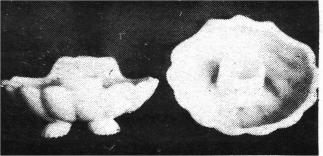Triangle C Finds - Shell Candlesticks
by Darlene and Joseph Bourque
Issue No. 119 - February 1983
EDITOR'S NOTE: This is another of a series of articles authored by Darlene and Joseph Bourque, and pertaining to the Cambridge Glass Company of Cambridge, Ohio. They are being printed herein through the courtesy and permission of DEPRESSION GLASS DAZE, a monthly publication devoted to the study and trade primarily of glass made during the depression and the years following. Information concerning the publication may be obtained by writing DEPRESSION GLASS DAZE, 12135 North State Road, Otisville, MI 48463.
Last winter, the outside was white all over. The snowflakes had fallen all morning long. According to the latest weather bulletin, the storm had turned into a "Nor-Easter" and was expected to last throughout the day.
I like snow. Snow is clean and brightens everything around it. As I sat back in my rocking chair sipping a cup of tea, I peered out the window to examine the flittering and glittering New England scene before me. I felt contented.
Beneath an oak tree in the yard, a lonely squirrel shifted from one spot to the other, digging into the frozen powder. He labored away, and seemed to dig a little deeper each time. After several attempts to find food, he emerged successfully, stood on his hind legs and held an acorn with his forepaws. He turned this acorn around and around examining it to insure himself it was not a cull. He set it aside and once more, I could see nothing of him but tail and hind legs. He emerged holding a second acorn and scrutinized it as before. Satisfied of his two finds, he placed them into his cheek pouches and happily he scurried across the hoary field to his tree nest to sate his appetite. Hmmm, I mused. It would be a good day for the hunt. The Cambridge glass hunt, that is.
I left the comfort and warmth of home and drove to the first shop which was more of a junk shop than an antique one as its sign stated. I left shortly with negative results. The second shop consisted mostly of furniture and the few pieces of glass present were uninteresting. I visited a few more like shops and was still without purchase. The wind had picked up some speed and the snow had become more dense.
The next shop I went to had closed because of the inclement weather. It was about time to quit. There was one more bric-a-brac shop on my way home. It was the sort of a shop where one had to move junk about in order to see what lay beneath the piles. As I entered I stamped the snow off my feet onto an already wet floor.
Upon looking about, I was greeted by an acquaintance who was a local dealer of antiquities. "Hello to you" I returned her greeting, adding "Any luck today?"
"Nothing worthwhile," she retorted. We spoke about the upcoming storm and regular things as do collectors and dealers. As we spoke, she fumbled about, moving junky items from one spot to another. She reached down and pulled out an item which was covered with gray dust. She examined it by turning it around once or twice in her gloved hands. To my surprise, she was non-committal towards the item and placed it back to the depth from whence it came, placing a few items on top of it as if to even out the array of junk on the counter top. I stood there speechless, yet forced myself to act unwaivered. The item she had dug out and re-buried appeared to be a Cambridge three footed shell ashtray. She left, thereafter, as we exchanged goodbyes.
I moved a cracked Depression Era plate, two nondescript tumblers and
a damaged china bowl aside and there lay the three footed Cambridge
shell dish. As I picked it up and brushed the dust off, I noted it was
blue in color. A super find. Upon examination I noted it was flawless.
But what a surprise I had when I looked inside the item. I discovered
 it was not an ashtray; it was a candle holder! A rare treasure. I did
not recall seeing this item in any text book, nor did I recall seeing
it in the Bennett Museum of Cambridge Glass in Cambridge, Ohio.
it was not an ashtray; it was a candle holder! A rare treasure. I did
not recall seeing this item in any text book, nor did I recall seeing
it in the Bennett Museum of Cambridge Glass in Cambridge, Ohio.
It was not priced. When I asked the shopkeeper the proverbial question of "How much?", he quoted a paltry sum of $3 for the pair! I must have had a startled reaction for the unexpected showing on my face for that one. "A pair?", I querried, as my adrenalin hit nine on the ten scale. I went back to that dark nook to shift a few more items around and there it lay, the second of a flawless pair.
As previously stated, they were blue in color. But oh, how eminently blue! The rarity of these shell candlesticks was the scarce blue color. They were Cambridge's Windsor Blue sometimes referred to as "milk blue."
Now I could go home. I had found my two acorns. The nature of the beast somewhat resembles that of man. As the squirrel, I too had satisfied my appetite for that weekend. A weekend with the "CCS" that is ("Cambridge Collector's Syndrome).
As of this writing, only two other such candleholders have been brought to my attention. Should you have one or a pair, please let me know. You may write me in care of the NCC address.
